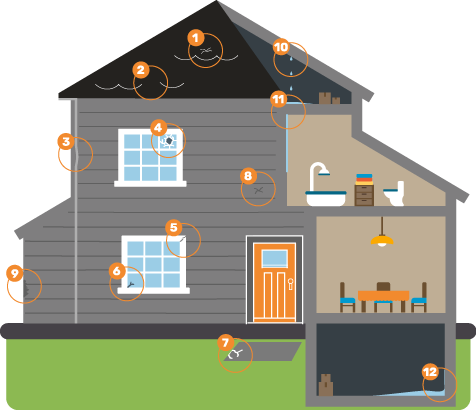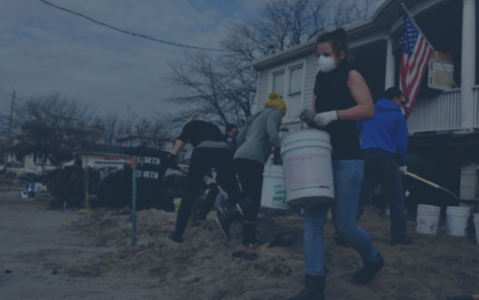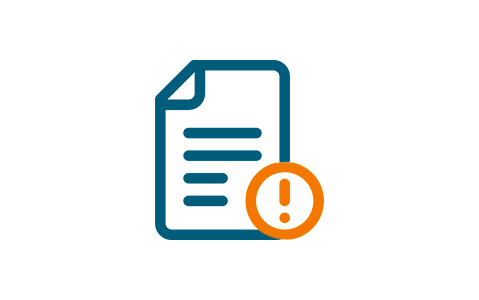
How to Clean Up After a Storm
The Essential Guide to Cleaning Up After Severe Weather
After a storm passes, it’s time to take a look at the damage your home suffered. Exercise caution while surveying your property, you may be walking through broken glass, crumbled drywall and fallen branches. There also may be hidden hazards, such as a downed power line or an unstable tree. In this section, we’ll show you how to clean up after a storm safely and smartly.
#1 Assess the Damage
How to Identify Storm Damage

1.
Damaged Shingles
Pitted and bruised shingles are common signs of hail damage.
2.
Missing or Lifted Shingles
Shingles close to your roof’s edge may be loose or completely missing.
3.
Damaged Gutters
Your gutters may be dented, hanging loose or filled with leaves and shingle asphalt granules.
4.
Shattered Panes
Windows are often broken during severe storms as a result of hail or debris strikes.
5.
Broken Frames
Your window frames may be broken as well, use caution when inspecting to avoid cutting yourself on broken glass.
6.
Cracks and Holes
Small pieces of debris can leave holes or cracks in window panes.
7.
Cracked Tile
Slate, concrete and ceramic tiles can crack or split as a result of hail and flying debris.
8.
Dented Siding
Like shingles, aluminum siding is vulnerable to dings and dents.
9.
Discoloration and Chipping
The sides of your house may be discolored due to chipped paint or cracks in the shakes.
10.
Attic Water Damage
If you are missing shingles, its possible water has seeped into your attic. Darkly-colored trusses and joists are a sign that water has leaked in.
11.
Wall and Ceiling Water Spots
If you notice new water stains on walls or ceilings, double-check the attic for roof leaks.
12.
Basement Leaks
Basements often leak during heavy rains, check for water marks on your walls or flooring if you have a finished basement.
Don't Wait to Call the Pros
"Your top priority after a flood is to get the water out as quickly as possible. Call a restoration company ASAP and get on their schedule. Don't wait until after you've talked to your insurance — they're going to be backed up and you need that water out fast. After major flooding with several feet of water, like we saw with Harvey and Irma, you need to call in the pros. If you try to DIY it with fans and shop vacs, you'll never get the water out in time to save your property and prevent mold growth."
— Paul Abrams | Public Relations Director, Roto-Rooter
Check Your HVAC Equipment
Central A/C Units
Before running your A/C unit, turn the system off at the thermostat. Then turn the unit’s circuit breaker at the main electrical panel “off” and then back to “on.” Wait 30 minutes before turning it back on from the thermostat. If the unit doesn’t turn back on after that time, it may need to be repaired.
Furnace
If your furnace was submerged in water, you will need to contact a licensed technician to inspect the unit for damage before turning it on.
Ventilation
If your ventilation system filled up with water, you should also contact an HVAC professional to drain and properly clean your vents to prevent mold from spreading to the other rooms of your home.
How You Can Help Others After a Disaster
1.Start by identifying your priorities and values when it comes to natural disasters. What matters to you? Children? Temporary housing? Long-term recovery?
2. Look for organizations that support your values and priorities by reviewing them on sites like GuideStar or Charity Navigator. Look for organizations with long-time experience and expertise in the affected areas. Brand new organizations may be good, but they are also riskier.
3. It's OK if you don't give right away after disaster strikes. It's likely that it will take a long time for a community to recover and your contribution may be even more valuable a month or even a year after the disaster."
— Robert G. Ottenhoff | President and CEO, Center for Disaster Philanthropy
#2 Start Cleaning Up Storm Debris
After assessing the damage, it’s time to start cleaning up the storm debris on your property. Depending on the severity of the storm, you may have a lot of work ahead of you. There may be trees, branches, sharp objects and even hazardous waste on your property.
Before you start picking up the pieces, make sure you take some basic precautions to protect you and your family. And if you plan to file an insurance claim, take photos of the damage as you work.
Follow These Safety Precautions When Cleaning Up Storm Debris
Keep children and pets away from floodwater, as well as damaged or hazardous materials.
Clean up and throw away open chemical containers separately to prevent dangerous reactions.
Do not drink the water or use the septic system until both have been inspected.

Avoid disturbing building debris that may contain asbestos or other hazardous materials. This can include:
- Floor Tiles
- Ceiling Panels
- Roofing Products (over 30 years old)
- Boiler and Copper Pipe Insulation
Have these supplies on hand for storm cleanup:
- Work Gloves
- Safety Glasses
- Heavy-Duty Trash Bags
- Chainsaw
- Waterproof Work Boots
- Respirator Mask
Find a Cleanup Solution for Storm Damage
There are a number of ways to dispose of storm debris, though the type of material and available services may narrow your options. Here are some common disposal solutions to look for in your area:
Curbside Collection
Most municipal trash collection services will accept vegetative waste, such as brush, yard trimmings and small tree limbs. Damaged building materials are generally not accepted as part of their normal service.
Storm Debris Collection
Local sanitation departments will usually schedule extra pickups after a severe storm specifically for large amounts of debris, including tree limbs larger than 4 inches in diameter and building materials.
Drop-Off Centers
If you have a lot of storm debris, you may have to haul the debris yourself to a designated drop-off center. Most yard waste can be disposed of in a solid waste landfill, while building materials can be taken to a construction and demolition landfill.
Dumpster Rental
If you can’t haul the storm debris yourself, a dumpster rental might be your best solution. Rental providers typically accept all non-hazardous materials, including yard waste (restrictions vary by location). Some common exceptions include electronics, appliances and mattresses. You can find alternative disposal options for these items on our bulk waste disposal page.
How to Clean Up After a Flood
If your basement floods, or your entire neighborhood experiences severe flooding, you may be waiting for days before a restoration company can get to your home. However, you can still help reduce the damage by following these steps:
1. Pump Out Water
Use either a wet-dry shop vacuum or your sump pump to drain any standing water. You want to remove the water as fast as possible to prevent any further damage to your home.
2. Get It Dry
Focus on preventing mold growth by drying out the affected areas as much as possible. Open all the windows and doors, then use box or oscillating fans to blow the air outside. The air should blow along the perimeter walls to keep mold from growing along the edges of the room.
3. Tear Up the Carpet
Remove any water-soaked carpet or padding as soon as possible. Carpeting is never salvageable after a flood and must be disposed of.
4. Throw Away Waterlogged Items
Rugs, upholstered furniture, cosmetics, stuffed animals, pillows, books, wall coverings and any other destroyed items should be thrown away.
Water Damage Cleanup Tips
Washable garments, towels and linens can be laundered in hot water and detergent. Items with visible mold are not restorable.
Hard items such as metal, glass, china and finished wood may be decontaminated and restored.
Wash all affected surfaces with a combination cleaner-disinfectant...or with household detergent and water, using a scrub brush or scraper for stubborn stains.
Saturate contaminated surfaces with a disinfectant cleaner or bleach solution (1 part bleach to 9 parts water) and keep wet for at least 10 minutes.
How to Clean Up Hazardous Materials
Call the Fire Department
Your local fire department will inspect or remove any hazardous items you may come across, including propane tanks and chemicals.
Protect Yourself
If you must handle hazardous materials, wear gloves and protective clothing that covers your skin completely, as well as a respirator if dealing with potential airborne contaminants.
Wash Up
If you come into contact with any hazardous materials, wash your skin immediately with soap and water.
How Long Does It Take to Restore a Flooded Home?
"The biggest factors are simply the restoration company’s ability to get to you and whether or not there’s power in your neighborhood. After a disaster, streets might be impassable for a while and there are only so many generators to go around if there’s no power.
Another factor is how much of the home is flooded. Part of the restoration process is to cut away the bottom three feet of drywall in any flooded room, to ensure there’s no mold growth. So, the more rooms, the more drywall will need to be removed and replaced."
— Paul Abrams | Public Relations Director, Roto-Rooter
#3 File a Claim and Rebuild With a Contractor or Restoration Service
If your home suffered significant damage, you should file a claim as soon as you start cleaning up the storm debris. Most insurance companies require policyholders to submit a claim within a given time period, usually up to a year after the damage occurs. But the sooner you submit yours, the faster you will receive compensation.
How to File a Claim
Contact Your Insurance Company
Call your provider and set up a meeting with a claims adjuster. They will inspect the structural damage to your home and estimate the cost of repairs. Most insurance companies will pay out an advance before the final settlement to get the repair process started.

Important Note for Mortgage Holders
"If you have a mortgage on your house, the check for repairs will generally be made out to both you and the mortgage lender. As a condition of granting a mortgage, lenders usually require that they are named in the homeowner's policy and that they are a party to any insurance payments related to the structure."

Find a Reputable Contractor
A general contractor or roofer can repair storm damage to your roof, windows, home exterior and structural damage limited to a single room of your property. Use word-of-mouth, online review sites and national associations to put together a list of potential contractors. Follow best practices while narrowing down your list:
- Get more than one estimate
- Ask for and verify references
- Ask for proof of insurance, licensure and bonding capacity
- Document everything
Assess Your Belongings
If your personal possessions were also damaged in the storm, use your home inventory to add up the total cost of your lost or ruined belongings. You can submit these items for compensation alongside your original insurance claim.


Reopen Your Claim if More Damage is Found
While repairing your home, you can reopen your insurance claim to include any additional structural damage uncovered during the rebuilding process.
How Disaster Relief Agencies Help Clean Up After a Storm
"Immediately after a disaster event we send our response teams in. That phase consists of work such as mucking and gutting homes, chainsaw removal of fallen trees, debris management and removal, mold sanitation of homes and, in general, cleaning things up and getting the initial mess managed to the extent we can."
— Tom Henry | Chief Operating Officer, All Hands and Hearts - Smart Response
"Once we have partners on the ground in an affected area, we work immediately to get the things we know are of great need into the community. Things like water, water-proof kitchen supplies, flashlights, batteries, radios, basic first aid kits, hygiene items, bedding and water purification tablets. We sometimes also provide things like cleaning materials, shovels and hand tools so that people can begin cleaning up their properties."
— Mary Dolan | Director of Communications, Operation USA
Benefits of Hiring a Restoration Company
If your home suffered severe water or fire damage throughout, you should call a restoration company in lieu of a contractor. These companies specialize in cleaning up storm debris, recovering belongings and restoring homes affected by natural disasters.
Call a Restoration Service for Severe Damage
Lower Costs
Restoration services focus on saving as much of the existing structure as possible, mitigating the costs of rebuilding your home.
Specialization
These services also have access to specialized equipment, including dehumidifiers and air movers, that can expedite the cleanup process.
Familiarity with Insurance Claims
Restoration companies work with insurance companies on a regular basis. They know the claims process and can provide cost estimates faster than a regular contractor.
How to Work With a Restoration Service
Do Not Wait for the Adjuster
Restoration and storm cleanup companies can provide emergency services in order to prevent further damage – though you may have to sign a waiver. You do not need permission from the adjuster for these services.


Review Major Repair Contracts
After your adjuster has assessed the damage and determined the payout amount, meet with the restoration company to go over the specifics of your contract. Contractors may not request full payment upfront, but periodic installments during the course of the project are allowed.
Report Discrepancies to Your Insurance Company
If there is any dispute over costs or previously unreported damage, contact your insurance company. They will work to resolve the dispute, but in case they fail to settle the issue you can contact your Department of Insurance.

Tips for Hiring a Restoration Service
Certifications
"Look for a company that's been certified by the IICRC, the Institute of Inspection, Cleaning and Restoration Certification. You'll know that they're following the most up-to-date practices in the industry."
Find Your Own
"Choose a restoration service yourself rather than going through your insurance company. Your policy will cover the work regardless, and this way you'll know the restoration service is working for your best interests, not your insurance company's bottom line."
— Paul Abrams | Public Relations Director, Roto-Rooter
After you’ve cleaned up the storm debris and fully repaired your home, you’ll be able to go back to business as usual. But remember to remain vigilant and look for signs of any previously hidden damage, such as water stains or noticeable cracks or breaks in the structural elements of your home. And before the next storm hits, remember to follow our storm preparedness advice to keep your home and family ahead of the weather.